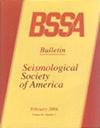The USGS 2023 Conterminous U.S. Time-Independent Earthquake Rupture Forecast
IF 2.9
3区 地球科学
Q2 GEOCHEMISTRY & GEOPHYSICS
引用次数: 3
Abstract
We present the 2023 U.S. Geological Survey time-independent earthquake rupture forecast for the conterminous United States, which gives authoritative estimates of the magnitude, location, and time-averaged frequency of potentially damaging earthquakes throughout the region. In addition to updating virtually all model components, a major focus has been to provide a better representation of epistemic uncertainties. For example, we have improved the representation of multifault ruptures, both in terms of allowing more and less fault connectivity than in the previous models, and in sweeping over a broader range of viable models. An unprecedented level of diagnostic information has been provided for assessing the model, and the development was overseen by a 19-member participatory review panel. Although we believe the new model embodies significant improvements and represents the best available science, we also discuss potential model limitations, including the applicability of logic tree branch weights with respect different types of hazard and risk metrics. Future improvements are also discussed, with deformation model enhancements being particularly worthy of pursuit, as well as better representation of sampling errors in the gridded seismicity components. We also plan to add time-dependent components, and assess implications with a wider range of hazard and risk metrics.美国地质调查局 2023 年美国大陆不定时地震破裂预测
我们介绍了美国地质调查局对美国大陆地区 2023 年与时间无关的地震破裂预测,该预测对整个地区潜在破坏性地震的震级、位置和时间平均频率做出了权威估计。除了更新几乎所有的模型组件外,一个主要重点是更好地表示认识上的不确定性。例如,我们改进了对多断层破裂的表述,与以前的模型相比,允许更多或更少的断层连通性,并涵盖了更广泛的可行模型。我们为评估模型提供了前所未有的诊断信息,并由一个由 19 名成员组成的参与式审查小组监督模型的开发。尽管我们认为新模型体现了重大改进并代表了现有的最佳科学,但我们也讨论了模型可能存在的局限性,包括逻辑树分支权重在不同类型的危害和风险度量方面的适用性。此外,我们还讨论了未来的改进措施,其中变形模型的改进尤为值得关注,网格化地震活动成分中的采样误差也应得到更好的体现。我们还计划增加随时间变化的成分,并评估与更多危害和风险指标相关的影响。
本文章由计算机程序翻译,如有差异,请以英文原文为准。
求助全文
约1分钟内获得全文
求助全文
来源期刊

Bulletin of the Seismological Society of America
地学-地球化学与地球物理
CiteScore
5.80
自引率
13.30%
发文量
140
审稿时长
3 months
期刊介绍:
The Bulletin of the Seismological Society of America, commonly referred to as BSSA, (ISSN 0037-1106) is the premier journal of advanced research in earthquake seismology and related disciplines. It first appeared in 1911 and became a bimonthly in 1963. Each issue is composed of scientific papers on the various aspects of seismology, including investigation of specific earthquakes, theoretical and observational studies of seismic waves, inverse methods for determining the structure of the Earth or the dynamics of the earthquake source, seismometry, earthquake hazard and risk estimation, seismotectonics, and earthquake engineering. Special issues focus on important earthquakes or rapidly changing topics in seismology. BSSA is published by the Seismological Society of America.
 求助内容:
求助内容: 应助结果提醒方式:
应助结果提醒方式:


